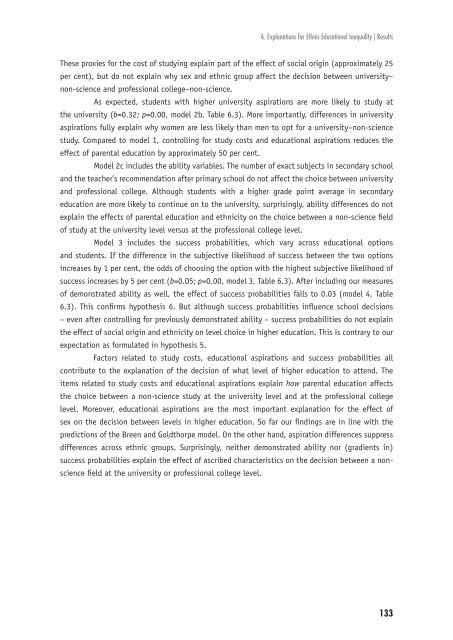Ethnic Hostility among Ethnic Majority and Minority Groups
Ethnic Hostility among Ethnic Majority and Minority Groups
Ethnic Hostility among Ethnic Majority and Minority Groups
Create successful ePaper yourself
Turn your PDF publications into a flip-book with our unique Google optimized e-Paper software.
6. Explanations for <strong>Ethnic</strong> Educational Inequality | Results<br />
These proxies for the cost of studying explain part of the effect of social origin (approximately 25<br />
per cent), but do not explain why sex <strong>and</strong> ethnic group affect the decision between university–<br />
non-science <strong>and</strong> professional college–non-science.<br />
As expected, students with higher university aspirations are more likely to study at<br />
the university (b=0.32; p=0.00, model 2b, Table 6.3). More importantly, differences in university<br />
aspirations fully explain why women are less likely than men to opt for a university–non-science<br />
study. Compared to model 1, controlling for study costs <strong>and</strong> educational aspirations reduces the<br />
effect of parental education by approximately 50 per cent.<br />
Model 2c includes the ability variables. The number of exact subjects in secondary school<br />
<strong>and</strong> the teacher’s recommendation after primary school do not affect the choice between university<br />
<strong>and</strong> professional college. Although students with a higher grade point average in secondary<br />
education are more likely to continue on to the university, surprisingly, ability differences do not<br />
explain the effects of parental education <strong>and</strong> ethnicity on the choice between a non-science fi eld<br />
of study at the university level versus at the professional college level.<br />
Model 3 includes the success probabilities, which vary across educational options<br />
<strong>and</strong> students. If the difference in the subjective likelihood of success between the two options<br />
increases by 1 per cent, the odds of choosing the option with the highest subjective likelihood of<br />
success increases by 5 per cent (b=0.05; p=0.00, model 3, Table 6.3). After including our measures<br />
of demonstrated ability as well, the effect of success probabilities falls to 0.03 (model 4, Table<br />
6.3). This confi rms hypothesis 6. But although success probabilities infl uence school decisions<br />
– even after controlling for previously demonstrated ability – success probabilities do not explain<br />
the effect of social origin <strong>and</strong> ethnicity on level choice in higher education. This is contrary to our<br />
expectation as formulated in hypothesis 5.<br />
Factors related to study costs, educational aspirations <strong>and</strong> success probabilities all<br />
contribute to the explanation of the decision of what level of higher education to attend. The<br />
items related to study costs <strong>and</strong> educational aspirations explain how parental education affects<br />
the choice between a non-science study at the university level <strong>and</strong> at the professional college<br />
level. Moreover, educational aspirations are the most important explanation for the effect of<br />
sex on the decision between levels in higher education. So far our fi ndings are in line with the<br />
predictions of the Breen <strong>and</strong> Goldthorpe model. On the other h<strong>and</strong>, aspiration differences suppress<br />
differences across ethnic groups. Surprisingly, neither demonstrated ability nor (gradients in)<br />
success probabilities explain the effect of ascribed characteristics on the decision between a nonscience<br />
fi eld at the university or professional college level.<br />
133












